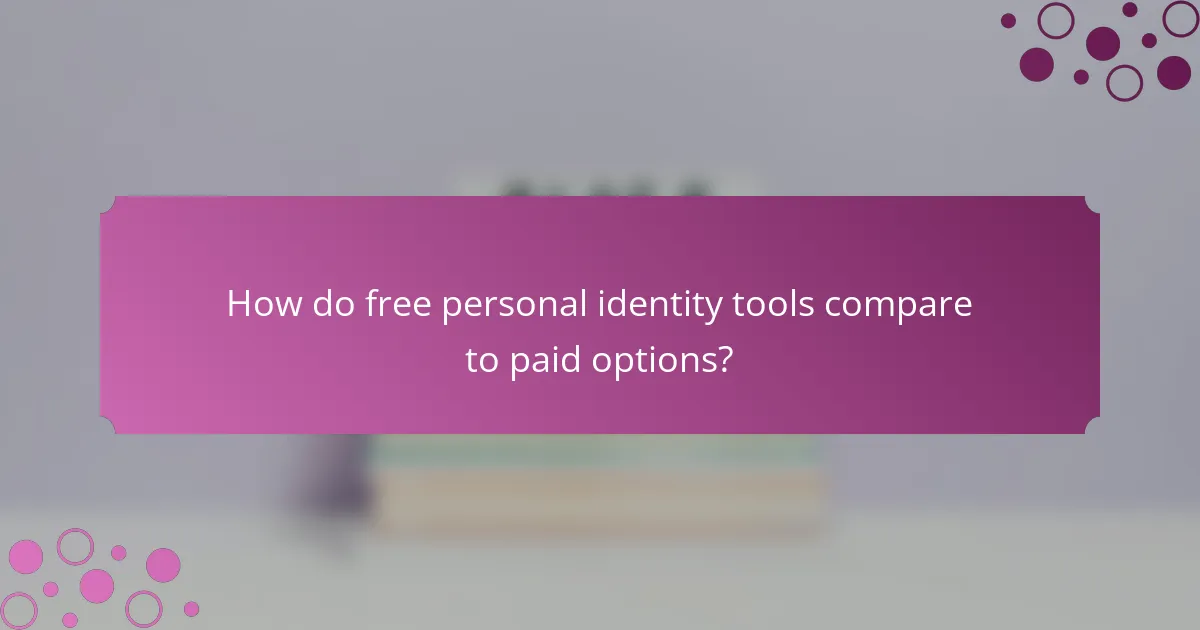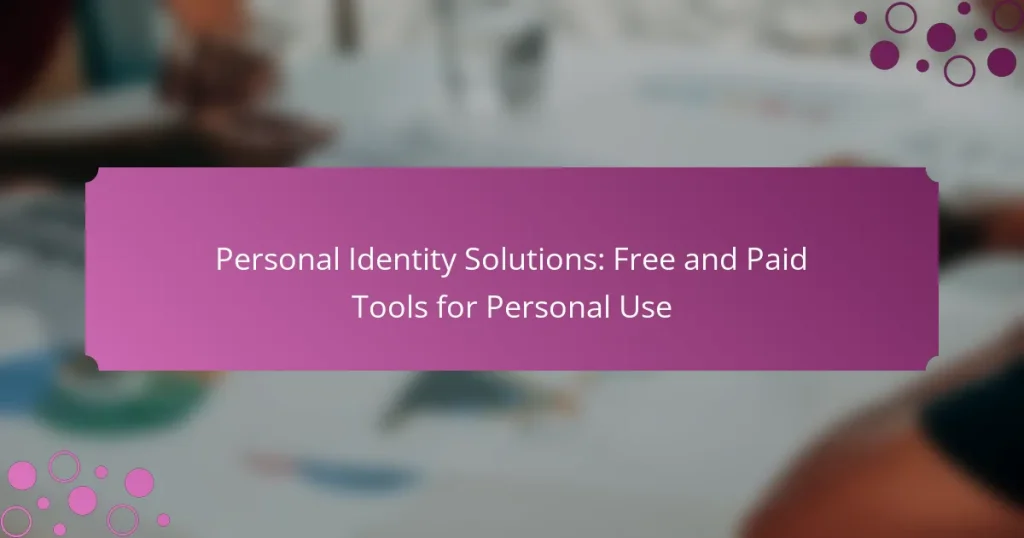In today’s digital age, managing your personal identity is crucial for ensuring security and privacy. A variety of tools, both free and paid, are available to help you safeguard your information, ranging from password managers to caller identification apps. While free options can provide basic functionality, investing in paid solutions often offers enhanced security features and greater usability for more complex identity management needs.

What are the best personal identity solutions in the UK?
The best personal identity solutions in the UK include a variety of tools designed to enhance security and manage personal information effectively. These solutions range from password management systems to caller identification apps, each serving distinct purposes to protect and streamline your digital identity.
LastPass for password management
LastPass is a popular password management tool that securely stores and encrypts your passwords. It allows users to generate strong passwords and autofill login credentials across various websites and applications, making it easier to manage multiple accounts.
Consider using LastPass if you frequently forget passwords or struggle to create unique ones for each account. The free version offers essential features, while the premium version includes advanced options like dark web monitoring and emergency access.
Truecaller for caller identification
Truecaller is an app that helps identify unknown callers and block spam calls. It uses a vast database of phone numbers to provide information about incoming calls, allowing users to avoid unwanted interruptions.
This tool is particularly useful in the UK, where nuisance calls can be common. Truecaller offers both free and premium versions, with the latter providing additional features like call recording and an ad-free experience.
Dashlane for secure storage
Dashlane is another robust password manager that offers secure storage for passwords, payment information, and personal documents. It features a user-friendly interface and provides a security dashboard to assess the strength of your passwords.
With Dashlane, you can access your information across devices, making it convenient for on-the-go use. The free version allows limited password storage, while the premium subscription offers unlimited access and additional security features.
Google Identity for account protection
Google Identity provides a comprehensive suite of tools for account protection, including two-factor authentication and security alerts. This service helps safeguard your Google accounts and personal information from unauthorized access.
Utilizing Google Identity is essential for anyone using Google services, as it enhances security and simplifies account recovery. Enabling two-factor authentication adds an extra layer of protection, making it harder for intruders to gain access.
Apple ID for device security
Apple ID is crucial for securing your Apple devices and services. It allows users to access iCloud, the App Store, and other Apple services while ensuring that personal data remains protected through strong encryption and authentication methods.
To maximize security, enable two-factor authentication on your Apple ID. This feature requires a verification code in addition to your password, significantly reducing the risk of unauthorized access to your devices and accounts.

How do free personal identity tools compare to paid options?
Free personal identity tools typically offer limited features compared to paid options, which provide more comprehensive services. While free tools can help with basic identity management, paid tools often include enhanced security measures and additional functionalities that cater to more complex needs.
Free tools offer basic features
Free personal identity tools usually provide essential functionalities such as password management, basic identity verification, and limited data storage. These tools are suitable for individuals who need simple solutions without extensive requirements.
Examples of free tools include password managers that store a limited number of passwords and basic identity verification services that check for common data breaches. However, users may find that these tools lack advanced features like multi-factor authentication or detailed monitoring.
Paid tools provide advanced security
Paid personal identity tools offer advanced security features, including robust encryption, identity theft protection, and comprehensive monitoring services. These tools are designed for users who require higher levels of security and are willing to invest in protecting their personal information.
For instance, many paid options include features like real-time alerts for suspicious activity, insurance against identity theft, and dedicated support services. The cost of these tools can vary widely, often ranging from a few dollars to several tens of dollars per month, depending on the level of service and features provided.

What are the key features to look for in personal identity tools?
Key features to consider in personal identity tools include data encryption capabilities, user-friendly interfaces, and multi-factor authentication. These elements enhance security, usability, and overall effectiveness in protecting personal information.
Data encryption capabilities
Data encryption is essential for safeguarding personal information from unauthorized access. Look for tools that use strong encryption standards, such as AES-256, which is widely recognized for its security. Tools that offer end-to-end encryption ensure that only you and authorized parties can access your data.
When evaluating encryption capabilities, check if the tool encrypts data both in transit and at rest. This dual-layer protection minimizes the risk of data breaches during transmission and while stored on servers.
User-friendly interfaces
A user-friendly interface is crucial for effectively managing personal identity tools. Tools should have intuitive navigation, clear instructions, and accessible features that allow users to easily understand and utilize the functionalities. A well-designed interface can significantly reduce the learning curve and enhance user experience.
Consider tools that offer customizable dashboards or quick access to frequently used features. This can help streamline your workflow and make it easier to manage your personal information efficiently.
Multi-factor authentication
Multi-factor authentication (MFA) adds an extra layer of security by requiring more than one form of verification to access your account. Look for tools that support various MFA methods, such as SMS codes, authenticator apps, or biometric verification. This reduces the likelihood of unauthorized access, even if your password is compromised.
When choosing a tool, ensure that the MFA process is straightforward and not overly cumbersome. A balance between security and convenience is essential, as overly complex authentication methods may deter regular use.

How can I choose the right personal identity solution?
Choosing the right personal identity solution involves assessing your specific needs, comparing user reviews, and evaluating pricing plans. Understanding what features are essential for you will guide your decision-making process.
Assess your specific needs
Start by identifying what you require from a personal identity solution. Consider aspects like data protection, ease of use, and integration with other tools. For instance, if you need a solution primarily for online security, prioritize options that offer strong encryption and multi-factor authentication.
Think about the types of personal information you need to manage. If you frequently share sensitive data, look for solutions that provide secure sharing capabilities. Make a list of must-have features versus nice-to-have ones to clarify your priorities.
Compare user reviews and ratings
User reviews and ratings can provide valuable insights into the effectiveness and reliability of different identity solutions. Check reputable review sites and forums to see what actual users are saying about their experiences. Look for patterns in feedback regarding usability, customer support, and performance.
Pay attention to both positive and negative reviews. A solution with a high rating but a few consistent complaints may still be worth considering, especially if the issues are not deal-breakers for you. Aim for solutions with a solid track record and a responsive support team.
Evaluate pricing plans
When evaluating pricing plans, consider both free and paid options. Free solutions may offer basic features, while paid plans typically provide advanced functionalities and better support. Compare the costs against the features offered to determine if the investment is justified.
Look for pricing tiers that match your budget and needs. Some services might charge a monthly fee, while others may offer annual subscriptions at a discounted rate. Be cautious of hidden fees and ensure you understand what each plan includes before making a commitment.

What are the privacy implications of using personal identity tools?
Using personal identity tools can significantly impact your privacy, as these tools often require sharing sensitive personal information. Users must understand how their data is collected, stored, and potentially shared with third parties, which can lead to privacy risks if not managed properly.
Data sharing policies
Data sharing policies dictate how personal identity tools handle user information. Many tools may share data with advertisers or partners, which can compromise user privacy. It is crucial to read the privacy policy of any tool to understand what data is collected and how it is used.
Look for tools that offer clear, transparent policies and allow users to control their data sharing preferences. Avoid tools that do not provide straightforward information about their data practices, as this can indicate potential risks.
Compliance with GDPR in the UK
The General Data Protection Regulation (GDPR) sets strict guidelines for data protection and privacy in the UK. Personal identity tools operating in the UK must comply with these regulations, ensuring that user data is processed lawfully and transparently.
When choosing a personal identity tool, verify that it adheres to GDPR requirements, such as obtaining explicit consent for data processing and allowing users to access or delete their information. Non-compliance can lead to significant penalties for companies and increased risks for users.

What are emerging trends in personal identity solutions?
Emerging trends in personal identity solutions focus on enhancing security, privacy, and user control. Innovations include decentralized identity systems, biometric authentication, and the integration of artificial intelligence to streamline identity verification processes.
Decentralized identity systems
Decentralized identity systems allow individuals to control their personal information without relying on a central authority. These systems use blockchain technology to securely store and manage identity data, giving users the ability to share only what is necessary for verification.
For example, a decentralized identity could enable a user to prove their age without revealing their full birth date or other personal details. This approach enhances privacy and reduces the risk of identity theft.
Biometric authentication
Biometric authentication methods, such as fingerprint scanning and facial recognition, are becoming increasingly popular for personal identity verification. These methods provide a high level of security because they rely on unique physical characteristics that are difficult to replicate.
While biometric systems can enhance security, they also raise privacy concerns. Users should consider the implications of storing biometric data and ensure that the systems they use comply with relevant regulations, such as GDPR in Europe.
Artificial intelligence in identity verification
Artificial intelligence (AI) is transforming identity verification by automating processes and improving accuracy. AI can analyze patterns in user behavior and detect anomalies, helping to identify potential fraud more effectively than traditional methods.
When implementing AI-driven identity solutions, organizations should prioritize transparency and user consent. Users should be informed about how their data is used and have the option to opt out of AI monitoring if desired.


